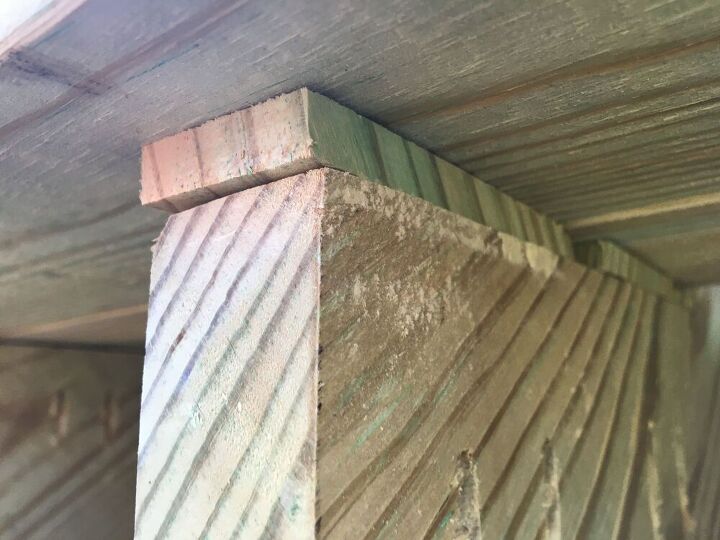Updating My Deck Part One: New Wide Stairs With a View!

I have good-sized back yard, large for my area (1/3 acre). With the COVID events I spent more time working from home. Out on the deck the main view when seated is basically just the handrail. I wanted to get rid of it, but that wouldn't be very safe, so I decided a better plan would be to replace a section of handrail with wide steps. Now you can see most of the back yard from most anywhere on the deck.
Here's my deck with plastic lattice skirting (ugh) underneath, the old top and bottom rail, balusters, and a drink rail at the top. The balusters don't meet code either, they're too far apart. The previous homeowners had left behind some scraggly rosebushes and crepe myrtles which I removed, a messy french drain, and plenty of other stuff to clean up. Notice the solar lanterns , they are coming down. Going modern ASAP
My sister now has the rosebushes etc : )
My back yard slopes down away from the house and also left to right. There are many stair calculators on the internet for rise and run, but with my irregular surface I had to get creative. I didn't want to pour a concrete slab/landing, it's not a look I wanted. I made a temp stair stringer out of a 1x12 I already had, and removed some old trim from the rim joist. This temp stringer had five stairs at 7" rise and 10" run. Using a level and trying it in place, that turned out to be much too tall. You can see I had to cut 4" off the bottom to make this come even close, which left a final height of 31". I used this template anyway to at least get the dirt more level before proceeding.
Since a 7" rise was too much, I went down to 6.5", which gave me a total height of 32.5", which means I'll be doing a bit of digging anyway. Using a standard square, I laid out my 6.5" rise and 10" run on new ground contact 2x12s from Lowes. I could have bought stair stringers pre-made, but I wanted a custom size for both rise (the deck height) and run (I had a cool idea for treads I wanted to use) so I made them myself. Instead of paying $16 each, I made two out of each $20 2x12x10' board, which took a few hours but saved me $60... and I got exactly what I wanted.
When cutting stringers a circular saw (in the background on the right) is much faster, but you don't want to cut too far and ruin your stringer. (The idea is to have a "2x6" left intact after your cuts). I got close enough with the circular saw and then got out the hand-held reciprocating saw to complete the cuts.
I completed the first stringer, measured it a couple of times, and then marked it up as #1 with top, bottom, etc. I used this same stringer to make markups so that all the following stringers would have the same template, hoping for some uniformity ( I'm no carpenter ; )
I got this notion to hide all the screws on the stair treads. If I didn't hide them I'm sure one or two would be out of alignment and it would bother me every time I looked at them. I also thought hiding the screws would be a nice touch. Here's a pocket hole jig in action. Each tread got two screws minimum at each step and stringer. Look closely and you can see I also pre-loaded the deck screws into the pocket holes. They aren't Kreg brand screws, but worked perfectly. Every stringer got 20 holes: Four at each step.
I started sorting the stringers based on appearance, so I could find the two that I wanted on the outside where they would be visible. I took time to make sure the one on each end would have the screws hidden to the inside
I bought a handful of galvanized $2 stringer hangers. They made the job much easier. I test fit a finished stringer against the deck for level, height, etc, and marked where the hangers would sit. I then ran a chalkline across the deck's rim joist and put marks every 16" (see red Sharpie mark above the hanger). I put up the hangers with one screw, checked for plumb, then added the second screw.
After the stringer hangers were on the deck joist, I placed the stringers themselves into the hangers. They require a handful of nails, or two deck screws (see yellow arrows). I used the same treated deck screws as I did for installing the hangars. Make sure each one is plumb and square before adding any screws
I checked each stringer for level against the next, and dug a hint more dirt out as necessary. While I was there landscape cloth seemed like a good idea. Not every stringer was perfectly identical so some adjustments had to be made.
Here is a corrected stringer that was just a bit too high. I used the handheld jigsaw to trim it (note how the cut above the screw isn't exactly straight). I wanted the treads to be as solid as possible with no creaks etc, so I did this a few times to get every mounting point right. A chalk line across the stringers helps you identify high spots too. After the high spots were corrected, I used a 1/4" cordless impact driver to put in the screws. The treads are 5/4, or true 1" thick decking boards, with two boards side by side running the full length. You can see a bit of overhang on the treads. Each deck board is just over 5.5" so when I add the vertical riser boards in a few weeks I'll have just the right overhang, or 'nose' as it's called.
and of course with my limited skills, a few were low. I had to make shims for three places where the treads met the stringers. I also had to take out the pre-loaded screws and use longer ones. When I was done every stringer and every tread was secure.
For the bottom tread my impact driver was too long to drive in the pre-loaded screws, so I took them all out by hand, and then used a toe nail method of attaching the treads. I used a screw on each side of each stringer for each tread (except for the ends) trying to keep one screw in front and one in back. For the ends I used two screws for each tread board from the inside.
My deck was not built by a professional. It's solid but has many odd characteristics. The posts are on 4' spaces, not 4' centers. Here you can see I cut off the two middle posts (the taller one still has an outlet I need to remove). These stairs are 12' wide. Having that much handrail gone makes basically the whole yard visible.
Before I put on the last tread board, I cut some 2x6 material to box in the last two spaces of the stringers. The outside stringer will have a handrail post bolted to it, and this will add sturdiness to the post and handrail when they are installed. Again I used the toe nail method, and you can see how I pre-installed screws in the board sitting on the tread in the photo.
Here are the completed stair stringers and treads. This is a super solid assembly, you don't feel any movement on any of the stepping points whatsoever. You can see I added some spacers on the outside at the bottom for the next 'step' 😉, so please ignore them, and here's me apologizing for forgetting to take a pic first. My engineering buddies at work say it's a good setup, and all of my techniques so far meet building codes in my locale. In all my projects I try to go above and beyond, so that the home will be more marketable when the time comes for me to sell and move on. I'm sure I'll enjoy this for years to come. BTW 100% of the screws are hidden! Almost time for mulch and some new landscaping. My next post is for the handrails. I hope in the near future to do the side rails, new risers, and a ton of LED lighting. My neighbors behind me have complimented the hard work and how nice it looks too : )
Please comment if you have ideas to make this easier for the next person (like buying stringers!) As always, Happy DIY/Hometalking!
Enjoyed the project?
Resources for this project:
See all materialsComments
Join the conversation
-
 Johnavallance82
on Jul 21, 2021
Johnavallance82
on Jul 21, 2021
Hi, I got the invitation for Mary to pop around and join you on the back porch!
-
-
 Johnavallance82
on Jul 26, 2021
Johnavallance82
on Jul 26, 2021
Hello again Jim,
How kind of you to extend the invitation to me (wish I could accept, but am in the UK)! I wrote to let you know the invitation had gone astray! kind regards. John
-














































Frequently asked questions
Have a question about this project?
Hello Jim,
Are you going to finish it off with a safety handrail?
Great job! I appreciate you showing the boo boos too. I built my deck myself and had many "adjustments" to make as a rookie. Curly wood is such a problem and I made so many errors. Thank you for sharing and it is beautiful! Enjoy using it and all the savings of doing it yourself! Marcie